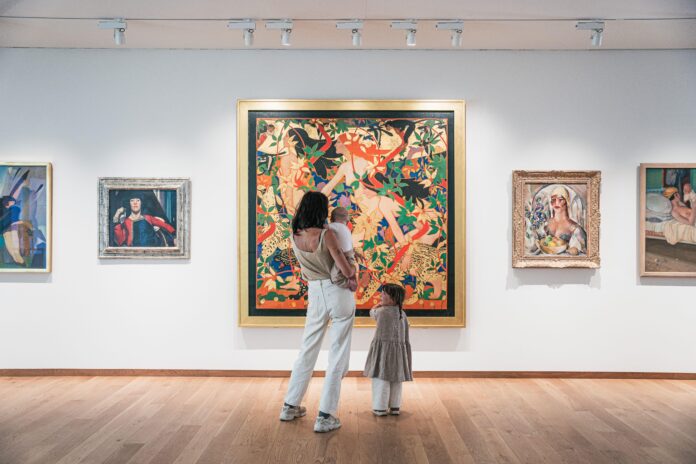A new home for the National Galleries of Scotland’s world-class collection of Scottish art will open to the public on 30 September after a seven-year, £38.62m redevelopment.
The new galleries, on the lower level of the National Gallery of Scotland in Edinburgh (now known as the National), double the exhibition space for Scottish art and showcases the collection of works made between 1800-1945. A new entrance from East Princes Street Gardens also makes the galleries much more visible than before.
The project, which involved building on a railway tunnel over the main Edinburgh-Glasgow line and excavating beneath the Grade A-listed National Gallery, has been been described as one of the most complex ever carried out on a heritage building in Scotland. The Scottish galleries have been closed to the public since 2016.
The National is one of Edinburgh’s leading visitor attractions, well known for having works by Old Masters such as Titian, Rembrandt and Diego Velázquez among its highlights. National Galleries of Scotland also, however, holds the largest collection of Scottish art in the world, numbering about 60,000 objects and including work by Charles Rennie Mackintosh, William McTaggart, the Scottish Colourists and the Glasgow Boys.
Patricia Allerston, deputy director and chief curator of European and Scottish Art at NGS and co-director of the redevelopment project, said: “It’s a rich historic collection and we haven’t done justice to it because we haven’t had the space.
“The art was always wonderful, but the spaces were developed in the 1970s and hadn’t been changed since. Less than 20 per cent of visitors to the National visited the Scottish collection. A lot of people didn’t realise it was a gallery, people thought it was the way to the cafe or the toilets.”
The curation beyond has also been overhauled with the narrative now beginning with the most recent work. Allerston said: “We know from research that very few of our visitors are specialists in art, far less in Scottish art. We want to get people excited about the collection so we decided to start with some of the best known, most colourful, most modern work and tease them into walking back through time.”
Women artists, meanwhile, are represented in greater numbers than before, in some cases by loans, including Cecile Walton, Agnes Miller Parker, Flora Macdonald Reid and Margaret Macdonald Mackintosh. Phoebe Anna Traquair’s embroideries, Progress of a Soul, 1895-1902, are among the many highlights selected with the help of visitor research.
The sense of revitalisation upon entering the new site will be immediate. Visitors arriving from Princes Street Gardens will find themselves face-to-face with William Johnstone’s large-scale abstract painting from the 1930s, A Point in Time, one of the only abstract works in the collection and a bold statement of a new set of curatorial intentions.
The first two rooms will, alongside the work of include works by the ever-popular Scottish Colourists, J.D. Fergusson, F.C.B. Cadell, Leslie Hunter and S.J. Peploe, shown, refreshingly, alongside other Scottish artists who explored Modernism rather than in a category of their own. One wall is dedicated to work by Charles Rennie Mackintosh and The Four.
A long gallery with windows into Princes Street Gardens displays landscapes of Edinburgh on one side (which playfully interact with the views from the windows) and a selection of Scottish landscapes on the other.
Smaller spaces on the right explore other “points in time”: symbolism and the Celtic revival; the Glasgow Boys (a pioneering group of young Modernists) represented across two rooms; the work of William McTaggart (the only artist given a dedicated survey) and a room called Art in the Making, which acts as a home for popular pictures that don’t fit easily elsewhere.
The tallest rooms at the south end explore the extensive Victorian collection, bringing together work inspired by Shakespeare, Dante, and, in particular, Sir Walter Scott. Scott then acts as a bridge on to a theme called Romance and Reality 1800-1895, which show works depicting a wild, untouched vision of Scotland. These works, the room acknowledges, were fashionable in the Victorian era but masked the reality of the Clearances—the forced evictions in the Scottish Highlands and islands in the 18th and 19th centuries.
This section includes important works from the collection such as Peter Graham’s Wandering Shadows (1878) and Henry Raeburn’s Col Alastair MacDonell of Glengarry (1810-12), the latter whose subject is anachronistically dressed as a Highland chieftain despite the fact that he cleared people from his land. It will also include Edwin Landseer’s Monarch of the Glen (1851), a momunental picture of a stag within a rugged Highlands landscape. The work is included despite the artist being English, due to the Scottish theme.
Patricia Allerston emphasises the complexities that come with reading Landseer’s work: “This is not reality, it’s a constructed idea, so we want to think about where that’s coming from, what it’s doing, what it’s not displaying. Monarch of the Glen is a great painting but it’s not a neutral painting.”

Sir Edwin Landseer, Monarch of the Glen (1851). Purchased by the National Galleries of Scotland as a part gift from Diageo Scotland Ltd, with contributions from The National Lottery Heritage Fund, Dunard Fund, Art Fund, the William Jacob Bequest, the Tam O’ Shanter Trust, the Turtleton Trust, and the K. T. Wiedemann Foundation, Inc. and through public appeal, 2017
Photo: Jane Barlow
The stag is a spectacular conclusion to the new galleries. Works by other well-known Scottish artists, such as David Wilkie, Allan Ramsay and the majority of the Raeburns, including the famous “skating minister” (The Reverend Robert Walker Skating on Duddingston Loch) can still be found upstairs in the National.
The new spaces, then, offer an indication of what could be a longer term intention to extend the fresh curatorial approach adopted in the Scottish galleries to the rest of the collection on the Mound. They represent, what could be an important miletone in fostering greater integration between Scottish artists and their European peers.

























